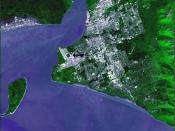There are certain features that all cities have in common, although these features vary in specifics. The city's structural settings such as size, density, pattern, grain and texture have various subcategories. These subcategories
A mixture of urban spaces and open spaces give a city depth and allows definition in interlinking districts. Districts are sections of the city conceived as having two dimensional context. The street layout and routes connect the buildings and sites within the districts, the districts with neighbouring districts and the city with the environment that surrounds it.
Cities are sometimes classified by roles: cultural, economic or administrative. These categories enable us to see obvious differences among most cities. For example, Chicago, São Paulo and Bombay are clearly economic or industrial cities. Boston, Benares and Rio de Janeiro have primarily cultural roles in their respective countries. Washington, D.C., New Delhi and Brasilia assume roles of governance.
No one can doubt that the structures of community life, histories, ethos, population profiles and expectations of these cities are broadly shaped or influenced by the roles they play in the larger society.
On a smaller scale, numerous port cities and market or county-seat towns maintain similar roles with equal regional significance for those seeking to design ministry strategies within them.
The size and density of cities vary in many cities. The size of a city is related to the shape of a city. When you think of the size of a city, you see the physical size of it. Cites are measured across the entire area or you can measure it from the centre to the outskirts. This decides on how big or small the city is. The density of a city is determined by the distribution of people and the cities urban massing. If the size of the city is...


